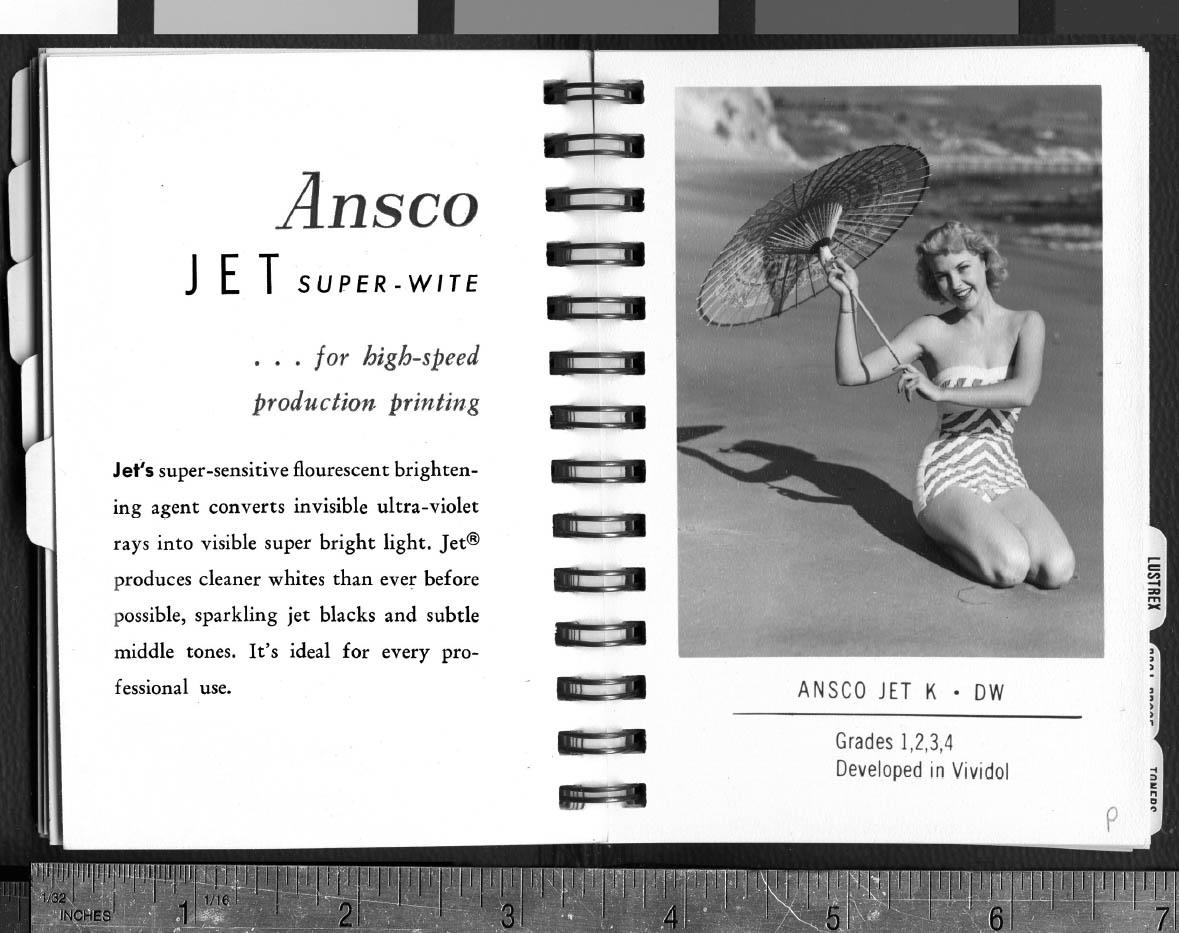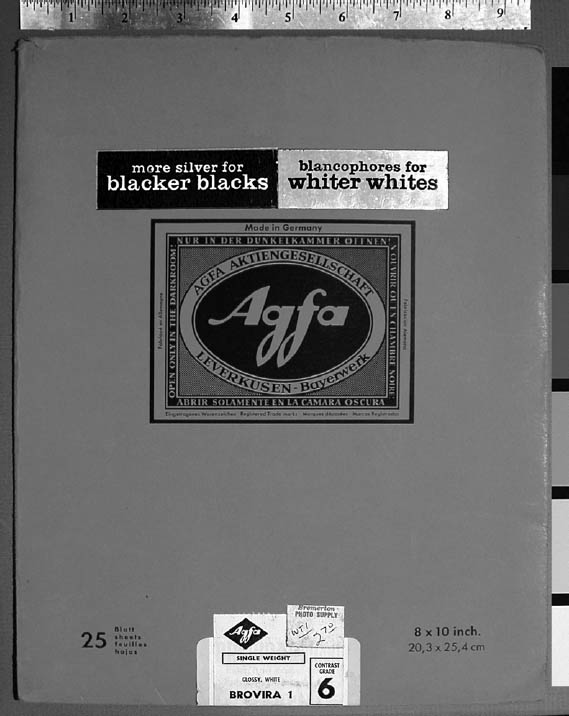OPTICAL BRIGHTENING AGENTS IN PHOTOGRAPHIC PAPERPaul Messier, Valerie Baas, Diane Tafilowski, & Lauren Varga
2 MATERIALS AND METHODS2.1 SAMPLE PREPARATIONSamples for this study come from a variety of sources but were mostly acquired from Internet auction sites starting in 1999. The samples fall into two broad categories: books of specimen prints and packages of unexposed photographic paper. Seventy-seven books of specimen prints were examined, contributing a total of 1,159 samples to the overall total. The earliest book of specimen prints dates from 1910. Books of specimen prints are an almost ideal source for this type of research, since they are usually dated and often provide a comprehensive inventory of a manufacturer's papers for a given year (fig. 1). In addition, they require no advance preparation for this type of an experiment. One drawback, however, is that some papers in books are mounted to a secondary support, making evaluation of the reverse of a sample difficult or impossible. The other main source of samples was original packages of unexposed photographic paper (fig. 2). The packages were opened in a photographic darkroom under safe light. A single sheet of paper was removed from the package. Two samples were cut from the sheet, each measuring 2 � 2 in. (5.08 � 5.08 cm). Any remaining sheet was returned to the package. Packages were resealed for storage in lighttight polypropylene bags. Samples were labeled with a catalog number in pencil on the reverse. They were fixed using ammonium thiosulfate, washed in water for 25 minutes, and air-dried. While requiring significantly more preparation than the books, papers removed from original packages were in some ways better suited for this study since they could always be assessed on both the recto and the verso. Papers taken from original packages contributed 645 samples to the study. The earliest paper had a manufacturer-applied expiration date of 1896. Only fiber-based, gelatin silver papers were assessed. Each sample was unique in that samples with duplicate brand, finish, emulsion, and date were eliminated from the survey. The paper samples come from a total of 40 manufacturers. Most of the historically prominent American and European manufacturers were represented, including Agfa, Agfa-Gevaert, American Aristotype, Ansco, Beseler, Boots, Cachet, Darko, Dassonville, Defender, Dupont, Forte, Gavaert, Guilleminot, Haloid, Ilford, Kilborn, Kodak, Luminos, Oriental, 3M, and Xerox, among others. The samples cover 264 different brand names and even more surface finishes, emulsion speeds, and base paper colors. 2.2 SAMPLE DATING AND IDENTIFICATIONEach of the samples in this study was identified by manufacturer, brand, and paper finish. This information was taken from specimen book labels or from the packaging of unexposed paper. Each sample was also dated. For specimen books, the dates were taken from the copyright date of the book, usually present inside While every paper in the study was dated according the methodology outlined above, some uncertainty remains when it comes to establishing an absolute chronology of the samples included in the study. The first is that the copyright date of a specimen book and the expiration date of a package of paper do not convey the same information. More important, the relationship between these dates and the actual manufacture date of a paper also requires some interpretation. Results from this study and any subsequent study based on similar reference collections of photographic paper will need to account for the differences between publication dates and expiration dates and for the relationship of these dates to actual manufacture dates.
For the purposes of this study, the publication date of a specimen book is assumed to be very close to the actual manufacture date of the papers presented in the book. Based on an examination of the sample books in the collection, it appears that most manufacturers produced these books annually, presenting updates and innovations in their line of papers. Nevertheless, it is possible that older papers could be included in a book if the older paper was still considered to be reasonably representative of current stock by the manufacturer. Expiration dates from packaged paper present a similar situation as these dates will always be after the actual manufacture date. While there has never been an industry standard, a two-year interval between manufacture date and expiration date would be reasonable for most papers, though intervals up to four and possibly five years appear possible. To provide some objective grounding for this observation, a comparison was made between the copyright date on processing instructions and expiration dates of the paper found in the same package. Eighty samples in the collection were found that contained both an expiration date and dated processing instructions within the same package. The 80 samples had a wide range of expiration dates, from 1911 to 1989. This procedure revealed that the average interval between the copyright date on the processing instructions (placed inside the package) and the expiration date (labeled outside the package) was 2.8 years.
There are indications that manufacturers used a wide variety of variables when determining the expiration dates of papers. The most significant factor in determining expiration dates was the speed of the emulsion. Faster emulsions for enlarging (silver bromide) papers were thought to “expire” more readily than slower emulsions (silver chloride and chlorobromide) that were more suitable for contact printing. Manufacturers realized that environmental conditions of temperature and humidity were by far the most significant variables affecting the keeping property of photographic paper and that these variables were largely beyond the control of the manufacturers. While better moisture-proof packaging and various proprietary chemical stabilizers were developed by manufacturers, there was a general consensus in the industry that expiration dates had fairly limited value in predicting whether a certain paper would behave according to specifications. Given the somewhat imperfect usefulness, Ansco Corporation deliberated over a period of years whether to drop expiration date labels (Krause 2003). Fortunately for this study, however, most manufacturers generally persisted in applying expiration date labels despite the limitations. Regrettably, a large proportion of papers gathered for this work from the Agfa Corporation were undated and therefore omitted from the sample group. To summarize the sample dating methodology: The dates used in this study are the copyright dates of specimen books and expiration dates of packaged papers. For most samples, specimen book dates are thought to be within a year of actual paper manufacture. Expiration dates are thought to postdate manufacture by approximately two years, though these may postdate manufacture by as little as one year and as much as four to five years for a small percentage of samples. Since publication dates and expiration dates are absolute, concrete values, and since no adjustment factor of these values would be entirely reliable, no attempt was made to normalize these values for this study. However, adjusting these dates to more accurately reflect manufacture date may be justified for future work using this or other reference collections. 2.3 DETECTION METHODSamples were examined visually in a darkened room using long-wave ultraviolet (UV) radiation in the range of 320 to 380 nm. The UV source was a handheld, 20W, 24 in. fluorescent tube “black light” manufactured by the General Electric Corporation. Most common optical brighteners have peak absorption in a range around 375 nm, with emission of a bluish white light peaking at approximately 450 nm (Mustalish 2000). Samples emitting this distinct fluorescent “glow” were tabulated. Samples were examined on both recto (emulsion side) and verso (paper base). As mentioned, some samples in specimen books were mounted overall to secondary supports, making a determination of fluorescence behavior of the verso impossible. In most cases, the subjective determination of whether brighteners were present was very clear-cut, as illustrated in section 4. However, the natural fluorescence of the gelatin and of the paper sizing and the reflection of blue light emitted by the UV source complicated matters when low levels of brighteners were present. Borderline cases were reexamined and usually resampled by the authors until a consensus opinion could be formed. Samples with indistinct fluorescence possibly attributed to optical brightening agents amounted to no more than 10 or 12 samples (less than 0.6% of the entire sample group). |


